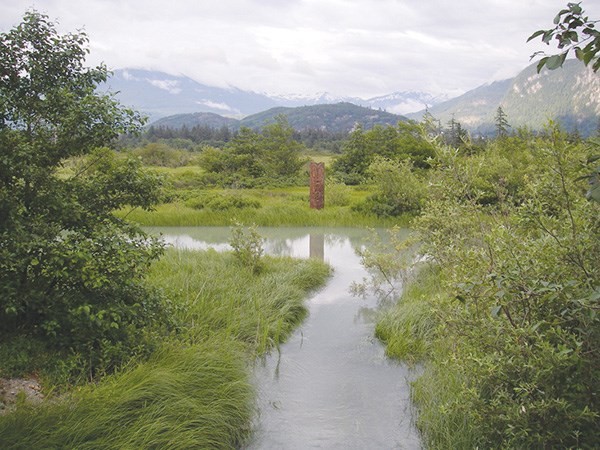Chelem Trail opened in September 2013 after the spoils from coal port dredging had been removed and the area returned to an almost natural state.
�鶹�����Environmental and �鶹�����River Watershed societies took the lead in building this new trail, also know as Marsh Trial, with funding from �鶹�����Savings Credit Union. Print copies of the commemorative painting by local artist Zoe Evamy are still available at zevamy.com.
There are three interpretive signs along the trail explaining the birdlife, marine life and vegetation of the estuary, as well as a welcome totem carved by a �鶹�����Nation artist.
Skwelwil’em Wildlife Management area covers most of the estuary with the purpose of restoring wildlife to this overly urban area.
25 years of bird counting
The estuary is a highly productive ecosystem that is used as a rest and feeding stop for migratory birds. The U.S./Canada migratory bird convention of 1916 is still in force to protect the routes of migrating birds. This convention also established feeding stops along the routes and our estuary is one of these mandated places.
Around 240 species of birds visit the estuary and these have been logged and tabulated for many decades. A program to place nests for purple martins on the old pilings was started in August.
The data for the past 25 years of bird counts by our local ornithologists has been passed to Quest University and Kim Dawe will be analyzing this valuable trove.
The abundance of nutrients from fresh river and salt tidal waters allows juvenile fish to flourish. It also provides the necessary mixing of salt and fresh water for salmon to adapt their gills when coming to spawn and leaving after birth. This vital fact makes estuaries critical to the life cycle of salmonids.
Much of the natural activity in the estuary is not visible as it happens beneath the water, in the mud and at night. Rest assured, though, that many creatures are active and struggling to fulfill their life cycle.
The vegetation screening the waterways has been deliberately placed to minimize the impact of humans on waterfowl and wildlife.
Keeping dogs on leash is mandatory and any invasion into wildlife spaces has negative consequences on the wildlife. Disturbing a nest often results in the fledglings being abandoned.
This is a posted Sensitive Habitat Area and violators are subject to fines (Call the conservation office at 877-952-7277 or #7277 if you see a violation).
Dealing with a coal port
This trail is on the area where dredge spoils from the aborted coal port project of 1971 were deposited. The spoil area was to become the storage space for huge piles of coal from the Rocky Mountains awaiting loading into ships bound for Asia.
Public pressure and environmental concerns led to the cancellation of the coal port by the provincial government.
The dredge spoils were harmful to the natural creatures inhabiting the estuary and had to be removed. Around 150,000 truckloads were taken out between 1999 and 2005.
The central area was then planted with sedge grass and native plants. A small amount of ocean sand was retained for the trail bed. �鶹�����Estuary Management Committee, which is made up of representatives from the District of Squamish, railroad, port, fisheries, recreation, �鶹�����Nation and provincial and environmental non-profits, is the long term authority over the estuary.
The training dike built for the coal port was passed to municipal control in 2005. This barrier is an important flood mitigation tool since the estuary acts as a huge sponge that eases the rate of floodwaters possibly entering our town. Windsport activities are restricted to the southern tip of the Spit Road.
Chelem Trail
An easy meander through open marsh in the central estuary.
Origin of name: Chelem is the �鶹�����Nation name for marsh grass or eelgrass, a common plant in our estuary.
Trailhead: At the parking space off Spit Road about four kilometres from Government Road.
Use: Multi-use non-motorized. Pets must be on leash.
Difficulty: Easy green.
Elevation: Four to six metres.
Etiquette: Do not damage sensitive terrain.
Feedback: [email protected]




